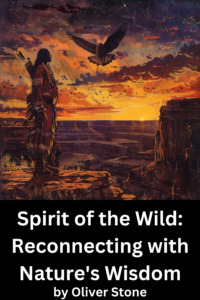How to Start a Fire with Flint and Steel A Survivalist’s Essential Skill
Introduction
Imagine standing in the vast wilderness, the chill of night descending swiftly. Your warmth and survival depend on your ability to start a fire. This age-old skill, cherished by the Apache and other indigenous peoples, is both an art and a necessity. Unlike modern methods, using flint and steel connects you to the ancient world, where fire was a sacred gift.
The Apache, renowned for their resourcefulness and keen understanding of nature, recognized fire as more than a mere tool. It was a symbol of life and renewal, a beacon in the dark that offered safety, warmth, and hope. Harnessing its power required knowledge, skill, and respect for the natural elements. By mastering the art of creating fire with flint and steel, you can tap into this powerful tradition and ensure your own survival in the wild.
In the glowing embers, wisdom dances, guiding us through the night with stories of those who came before.
To embark on this journey, one must understand the right tools and techniques. First, gather the essential components: a piece of high-carbon steel and a shard of flint. Together, these create a spark–a tiny ember that, with patience and care, can blossom into a vital flame. This process fosters a deep connection with nature, offering not just physical warmth but also a profound sense of accomplishment.
Historical Context
The Apache people have long been regarded for their profound connection with nature, seamlessly integrating survival skills into their daily lives. Flint and steel, elemental tools in wilderness survival, were often the choice of indigenous tribes, esteemed for their reliability in various weather conditions. These tools were not merely instruments but extensions of the Apache relationship with the land, allowing them to harness the earths raw energy for warmth and sustenance. Mastery of fire-making was not just a practical skill but also a rite of passage, symbolizing a deep understanding of nature and a commitment to community well-being.
Apache traditions emphasize adaptability, teaching that understanding and utilizing available resources is key to survival. This principle, deeply rooted in Apache culture, ensured resilience in harsh environments where resources could be scarce. The art of starting a fire with flint and steel reflects this adaptability, showcasing their ability to derive utility from natural materials found in their landscapes. By perfecting such skills, the Apache thrived, maintaining a harmonious balance with their surroundings while ensuring their own survival.
There’s timeless wisdom in the Apache approach, encapsulated in their philosophy:
Learn how to listen, and you will learn from every source.
This belief underscores the necessity of observing and interacting with the world to extract its lessons. Fire-making with flint and steel embodies this wisdom, a testament to listening to the natural world and learning to manipulate its elements for survival. This skill is a bridge between ancient wisdom and modern survival techniques, reminding us of the enduring power of ancestral knowledge.
Today, the legacy of Apache fire-making techniques continues to inspire survivalists and outdoor enthusiasts. Simplicity and effectiveness of flint and steel demonstrate the ingenuity of traditional methods in a world increasingly dominated by complex technologies. These skills not only serve practical purposes but also foster a deeper appreciation for the resourcefulness of indigenous cultures. By embracing these time-honored methods, individuals can connect with a rich heritage that highlights the profound interaction between humanity and nature.
Apache Flint Steel Fire Starting Survival
An Apache Story
The Apache people, renowned for their resourcefulness and connection with nature, have passed down invaluable wisdom through generations. Their survival skills, especially their ability to start a fire using simple tools, highlight their intimate understanding of the natural world. Fire, to the Apache, symbolizes warmth, protection, and the sustenance of life itself.
Apache legends often speak of the sacred process of fire-making, treating it as a ceremony that requires respect and gratitude. Using flint and steel, they not only mastered fire creation but also emphasized principles of patience and observation. This knowledge ensured their ability to thrive in diverse environments, adapting to the challenges posed by nature with finesse.
The tools involved, particularly flint and steel, were chosen for their reliability and availability. Apaches would gather appropriate materials by observing the land closely, ensuring they only took what nature offered willingly. This practice reflected their deep-seated belief in balance and harmony with their surroundings.
A traditional Apache approach to fire-making encourages careful preparation and reverence for the elements. They would construct a secure environment, arranging tinder and kindling precisely to catch the spark effectively. Every step was performed with intention, echoing an appreciation for the interconnectedness of all things.
Apaches believed in utilizing resources wisely, so every fire served multiple purposes: cooking, signaling, and keeping predators at bay. This holistic approach ensured nothing went to waste. Such efficiency remains a testament to their enduring wisdom and the timeless nature of their survival techniques.
In the heart of the Apache lands, beneath a sky woven with stars, lay a peaceful village shadowed by the threat of a rival clan. Brave warriors stood ready to defend their home, chief among them, Places, known for his fearless spirit and keen survival instincts. This is the story of how Places used his skills not only to defend but to unite his people through the essential survival art of fire-making.
The Flicker of Preparation
As dusk settled over the vast desert, Places gathered with Tacoma, the wise elder, and his trusted friend Way, beneath the ancient juniper tree. Scent of juniper filled the air, earthy and calming, as Tacoma began speaking, Places, a warrior knows many battles are won before they are even fought. Fire is life–let us kindle it as our ancestors did.
Places nodded, feeling the rough texture of the flint stone in his hand, its coolness anchoring him to the task ahead. Way, with his deft fingers, arranged the kindling–a delicate dance of dry brush and twigs, each piece gathered with respect from the land. Remember, Way smiled, the spark is the whisper of life; listen closely.
In the soft glow of the moon, Places struck true, the flint and steel creating a shower of bright sparks that scattered like a constellation upon the waiting tinder. The fire came to life with a gentle crackle, as if stirred from a deep sleep. As they watched the flames grow, Places understood this was more than just making fire–it was igniting hope.
The Flames of Defense
The following night, a chill wind carried the distant drumbeats of the approaching rival clan. Village was tense, but Places remained focused, teaching others the art of fire-making. Every warrior here, Places announced, must learn to bring light from stone and steel, for it is not just a weapon, but also a guide.
Tacoma watched with pride as Places demonstrated, the light of each new flame illuminating determined faces. Places, Tacoma said softly, this is how our people endure. Not by force alone, but by sharing wisdom.
Way, ever resourceful, crafted torches from resinous wood, their ends wrapped securely with cloth. The light will dance before us tonight, Places, much like the tales we were told as children, he mused, his laughter contagious. It spread warmth among the gathered warriors, binding them together with an ember-like resilience.
The Embers of Unity
When the rival clan appeared at the horizon, the village was ready. Torches flared like small suns along the perimeter, each carried by a warrior who trusted in the skill Places had taught them. Na comas words echoed in LA-eshs mind: We fight not just for survival, but for unity and the future we protect.
The confrontation was fierce but brief. When the enemy retreated, humbled by the unexpected strength of unity and light, the village erupted in songs of victory. Each note a tribute to their courage and resilience. The fires, bright against the night, seemed to sway in agreement.
As dawn broke, Places stood by the embers of the central fire, reflecting on what had been achieved. Way clapped him on the shoulder, Together, we kindled more than flames, brother. Tacoma, nodding wisely, added, And so we keep the spirit of our people alive.
The tale of that night would be told for generations, a reminder of how fire-starting became a symbol of unity and life. As you consider this story, what flames of knowledge could you kindle in your own life to illuminate the paths of others?
Practical Applications
How to Start a Fire with Flint and Steel: A Survivalists Essential Skill
Starting a fire with flint and steel is a fundamental skill for any survival enthusiast. Integrating this skill into daily life can improve your preparedness and self-reliance. Here’s a detailed, step-by-step guide to help you master this art.
- Gather Your Supplies
The basic items you’ll need include flint, steel, and dry tinder such as birchbark, cotton, or char cloth. Ensure your tools are in good condition and easily accessible when needed.
- Choose the Right Location
Find a safe, sheltered spot away from wind and moisture. Clear the area of debris, ensuring nothing flammable is nearby to prevent unwanted fires.
- Prepare Your Tinder Bundle
Form a nest-like bundle with your tinder. It should be loose enough to allow air circulation but compact enough to catch a spark effectively.
- Strike Flint and Steel
Hold the flint firmly in one hand. Strike it with the steel at a 30-degree angle, aiming to direct sparks into the tinder bundle. Practice this motion to achieve consistent results.
- Nurture the Spark
Once the spark lands on the tinder, gently blow on it to encourage the ember. Gradually add small twigs to build the flame, transitioning to larger kindling once the fire is stable.
- Manage and Sustain the Fire
Pay attention to the airflow and fuel supply. Maintain the fire by adding larger logs sparingly, ensuring it doesn’t become too large or smoky.
- Practice Regularly
To refine your skill, practice starting a fire in different weather conditions. This builds confidence and ensures you can rely on this method when necessary.
Potential Challenges and How to Overcome Them
One challenge is dealing with wet or damp tinder, which struggles to catch a spark. Overcome this by carrying dry tinder in a waterproof bag. Another common issue is striking at the correct angle; practice regularly to improve accuracy. Windy conditions can blow out your spark; create a windbreak or use your body as a shield.
Tips for Maintaining Consistency
Incorporate fire-starting practice into routine activities, such as during camping trips or backyard bonfires. Keep your flint and steel in a dedicated survival kit so you’re always prepared. Regularly inspect and maintain your tools to ensure they’re ready for use. By practicing consistently, you’ll build confidence and competence.
Learning to start a fire with flint and steel is not just a survival skill–its a connection to ancient traditions and a test of your resourcefulness. Why not challenge yourself to light your next campfire using this method? You’ll deepen your appreciation for the skill and enhance your survival abilities.
Apache Flint Steel Fire Starting Survival
Conclusion
Mastering the skill of starting a fire with flint and steel, inspired by Apache wisdom, connects us with our ancestral roots and the natural world. Throughout this journey, we’ve explored the significance of selecting the right materials, the importance of technique, and the patience required to nurture a spark into a flame. This traditional method not only ensures survival in the wilderness but also fosters self-reliance and a deep respect for natures elements. By adopting these practices, you embrace resourcefulness and an understanding of a skill honed by generations past.
Wisdom is not a product of schooling but of the lifelong attempt to acquire it. — Inspired by ancient teachings
Incorporating these techniques into your outdoor experiences can transform a simple camping trip into a meaningful connection with history and nature. As you practice this skill, consider the insight and creativity our predecessors exhibited when they relied solely on natural resources. Allow each strike of your flint to echo the perseverance and ingenuity of the Apache who mastered these elements out of necessity. As you walk this journey, remember that every spark is a step toward sustaining life in its most primal form.
Awaken your inner survivalist by continuing to refine this essential skill, and share your knowledge with others. Perhaps join a community of like-minded enthusiasts to exchange tips and stories, further deepening your understanding. Your newfound expertise not only equips you for potential challenges but also pays homage to traditions that echo through the ages. Embrace this wisdom and carry it forward; let each fire you kindle remind you of both the fragility and resilience of life.
More Resources
Dive deeper into the fascinating world of Apache wisdom and its modern applications. Explore these thought-provoking questions to expand your understanding of the concepts discussed in this article.
Explore Further with Google
- How can we practice tribal ceremonies in our societal issues?
- How can we revitalize ancestral traditions in our education systems?
- How can traditional ecological knowledge inform modern conservation efforts?
Discover Insights with Perplexity
- How do traditional practices influence environmental stewardship?
- How do traditional storytelling methods convey timeless wisdom?
- How do ancestral teachings contribute to personal growth?
By exploring these questions, you’ll gain a richer appreciation for indigenous cultures, environmental stewardship, and mindfulness practices. Each link opens a gateway to deeper knowledge, helping you connect ancient wisdom with contemporary life.
Thank you for reading!







